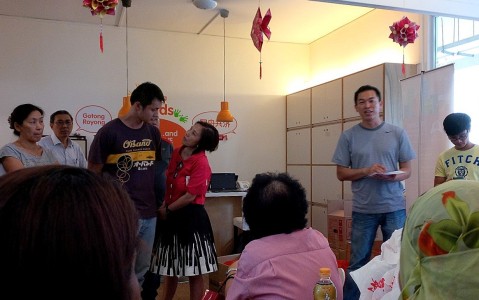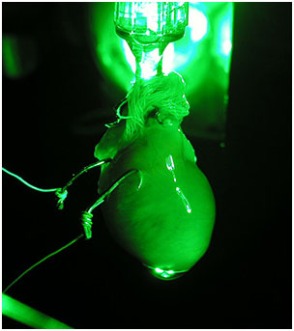Update From Modern Aging Singapore: Kickoff Workshop

Modern Aging Singapore kicked off in the middle of August. So far, the program has seen active participation and support from aspiring entrepreneurs. About three hundred students, health practitioners, researchers, and members of the public attended the Kickoff Workshop held at the NUS I Cube Building Auditorium on the morning of August 15.
Attendees were treated to four presentations from experts in aging and business: Overview of Aging by Prof. Angelique Chan of Duke-NUS Graduate Medical School, Healthcare and Business by Dr. Jeremy Lim of Oliver Wyman, Home and Center Based Care by Dr. Ng Wai Chong of the Tsao Foundation, and Product Design for Seniors by Hunn Wai of design firm Lanzavecchia + Wai.
 Prof. Chan highlighted some key trends and statistics on aging in Singapore. One surprising point was the high prevalence of social isolation among seniors here. This finding spurred aspiring entrepreneurs to think of novel solutions to address this trend.
Prof. Chan highlighted some key trends and statistics on aging in Singapore. One surprising point was the high prevalence of social isolation among seniors here. This finding spurred aspiring entrepreneurs to think of novel solutions to address this trend.
Dr. Lim went on to outline the aging sector in terms of business potential. One suprising finding, according to theNational Center for Policy Analysis, is the average net worth in 2010 was 848,000 USD for sixty five to seventy four year olds and nearly seven hundred thousand dollars for those above seventy five. These figures encouraged aspiring entrepreneurs to enter the aging sector.
Dr. Ng discussed the current status of home and center based care in Singapore. He highlighted specific needs in these care settings frequently used by seniors. This discussion allowed aspiring entrepreneurs to hone in on key areas of need and address these pain points. For example, some challenges in these settings include the quick and painless transferring of patients from bed to chair and vice versa, and increasing the time health practitioners can spend with seniors.
Mr. Wai rounded off the presentations with insights from product and design perspectives. He introduced examples of good design for seniors, such as mixed use canes and walkers, or stylish back braces. This presentation especially inspired aspiring entrepreneurs to consider seniors’ lifestyles and tastes when introducing new product ideas.
In addition to expert presentations, attendees also heard two senior role models share their life experiences and lessons. Younger members of the audience seemed glad to hear the wise advice dispensed by the seniors. The kickoff event concluded with a networking lunch. Participants became so engrossed in conversations around aging that they lingered past the scheduled end time.
Currently, Modern Aging Singapore has progressed to the business curriculum and selection phase. The top twenty teams have been selected and paired with industry mentors to hone their business ideas. The twenty teams will soon be pitching at the semifinals judging event for the top six spots. Meanwhile, all participants of Modern Aging Singapore are able to access the same business and aging curriculum on the Modern Aging Online Learning Portal to continue learning and improving their business ideas. If you would like to access the Portal, please write an email request to info@modernaging.org.
Find out more about Modern Aging, at www.modernaging.org.
Informal Child and Elder Care in Singapore: South Central Community Family Service Center
At ACCESS Health International, we like to feature good examples of community and elder care. A recent visit to the South Central Community Family Service Center in Singapore reveals a thriving space where different generations of neighbors visit, work, and play with one another.
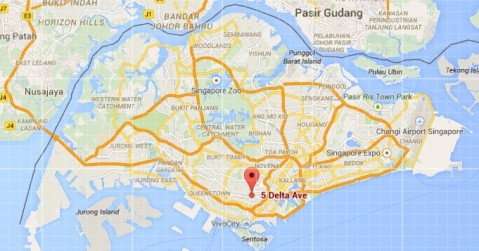
The South Central Community Family Service Center is located in the southern part of Singapore. The Center is shown as a red dot on the map.
The South Central Community Family Service Center is just one of many other Family Service Centers in Singapore. Family Service Centers are an important part of the “Many Helping Hands” approach of the Singapore government toward social services. The Many Helping Hands approach emphasizes the involvement of multiple sectors in providing for the social welfare needs of people. Family Service Centers are run by Voluntary Welfare Organizations and are supported by the Ministry of Social and Family Development, the National Council of Social Services, Community Chest, or the Singapore Totalisator Board [1]. This is one way the government supports and encourages care provision by nongovernmental entities.
The South Central Community Family Service Center is unique in one respect. In January 2013, the Center became an independent entity with its own board of directors. The mission of South Central Community Family Service Center remains the same: to promote the wellbeing and self reliance of families. The main focus is supporting lower income individuals and families in the Bukit Ho Swee, Henderson, Redhill, and Indus Road neighborhoods. Between 2013 and 2014, the Center managed an average of four hundred cases. Casework involves counseling or referral to specialized services. For example, children from families lacking in basic necessities may face challenges in schoolwork or dealing with classmates. Center staff can counsel children or their parents on managing these problems. Where necessary, families are referred to other services, such as specialized psychiatric help or financial aid.
Besides casework, another focus of the Center is community engagement. To this end, Center staff organize events to involve nearby residents and create community spirit. As the Center is located on the ground floor of a block of residential flats, it is accessible and open to residents in the neighborhood. Our visit took place during the Lunar New Year period. As seen in the photo, festive decorations lining the entrance created a welcoming and friendly atmosphere.
Outreach worker Erwin showed us around the Center. Erwin explained to us that a guiding principle for the Center and staff is community cooperation and participation. This principle is informed by the Asset Based Community Development approach to community work. This approach ensures sustainability because initiatives are driven by the residents themselves. Residents volunteer to help care for their neighbors’ elderly relatives or children. Residents worked together to plant a community garden full of useful medicinal herbs.
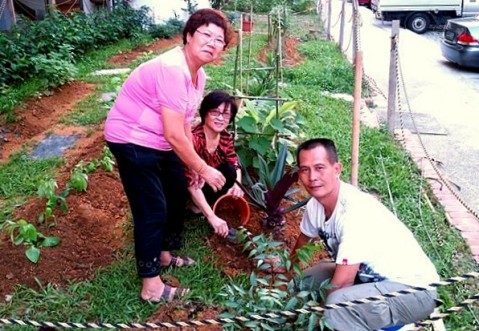
Residents take ownership of the community garden and bond while caring for the plants. (Photo: South Central Community Family Service Center)
The Center is a collaborative environment. The community garden is a visible fruit of this collaborative environment. The garden had been an empty space in front of the Center. Center staff wanted to galvanize residents to work on a common project. Residents contributed ideas and voted for the winning project: a medicinal herb and vegetable garden. Because the idea came from residents, the garden has been adopted and cared for by residents.
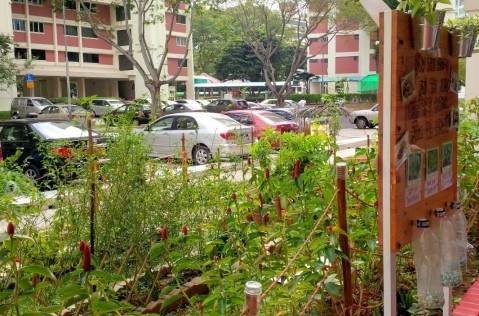
Residents contribute ideas to keep the garden fresh and growing. Residents can vote for the next plant type by placing a marble in the respective bottle.
In the picture above, one can see a board where residents can vote on the next plant type. At the time of visit, sweet potato leaf was the leading candidate. The board itself was constructed by hand by a resident who is a carpenter by trade.
Inside the Center hangs another board, where residents can request items or services they need, or post offers of items or services they can give. The platform helps match community resources to people who need them most.
Residents streamed in and out of the Center throughout our visit. Erwin pointed out a pair of young siblings playing games on the couch. Erwin told me the siblings come to the Center after school ends to wait for their parents to get off work. I also saw groups of elderly chatting with one another at tables and chairs. The open space created by the South Central Community Family Service Center helps with informal child and elder care as residents look out for and engage with one another.
Near the end of our visit, there was a briefing for a large group of about twenty five volunteers, both young and old. They were preparing to give out yusheng packs to shop owners and residents at the Lengkok Bahru neighborhood. This showcased lower income families and children as goodwill ambassadors as part of this “Lo Hei Outreach”. The yusheng salad is traditionally eaten during the Lunar New Year, and Lo Hei is the dialect term for tossing the salad. Family and friends gather to Lo Hei together, signifying prosperity and togetherness. The briefing was punchy and positive with the staff recognizing the contributions of volunteers.
The South Central Community Family Service Center is an example of successful informal community and elder care. The staff and volunteers have created an open venue where residents are encouraged to join community activities and contribute their talents. Can their model of community involvement and ownership be replicated elsewhere? For example, could elder care as a larger industry move toward being more community based and operated? Share your thoughts with us by leaving a comment.
1. The Singapore Totalisator Board, also known as Tote Board, manages the surplus funds generated by Singapore Turf Club and Singapore Pools. They channel funds in support of various causes in Singapore such as arts and culture, social services, community development, education, health, and sports.
Taking a Cue from Lee Kuan Yew on Aging Well
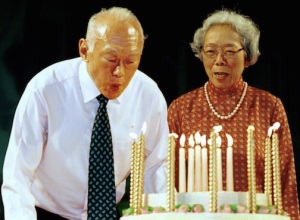
Mr. Lee celebrating his seventy seventh birthday with his wife, Kwa Geok Choo, on September 16, 2000. (Photo: Edward Wray, Associated Press)
Lee Kuan Yew, the founding prime minister of Singapore, passed away on Monday morning. As the first prime minister, Mr. Lee helped shape many policies in the formative years of independence. As the Singapore population matured, aging became an issue of concern for Mr. Lee. He shared some personal views on aging at a forum in 2010, when he himself was close to ninety.
Mr. Lee said, “I think the most important single lesson I learned in life was that if you isolate yourself, you’re done for. The human being is a social animal – he needs stimuli, he needs to meet people, to catch up with the world.”
Mr. Lee also said, “You must have an interest in life… If you’re not interested in the world and the world is not interested in you, the biggest punishment a man can receive is total isolation in a dungeon, black and complete withdrawal of all stimuli, that’s real torture.”
Indeed, part of aging well is maintaining social support and engagement in activities. Population trends in Singapore indicate that, in the future, many more elderly will be single and living alone. We must create opportunities to help these elderly avoid isolation.
How can this be done? Many are thinking of solutions. The ACCESS Health Singapore team spoke to a professor in architecture. She explained to us that simply adding a small space to common corridors for residents to sit and mingle can draw them out of their flats. Eventually, she said, the residents may venture down their blocks and into the community.
There must be other ways to help our elderly age well. People from all sectors are thinking of novel ways to make a difference in the Singapore silver industry, a promising development. Mr. Lee’s advice was for individuals to take an interest in the world and to avoid isolation. How we can help is to think of creative ways to encourage these individuals to do so.
Perhaps then we can live out Mr. Lee’s wish, “Have a purpose driven life and finish well, my friends.”
Retirees on Speaking Exchange with Brazilian English students
Ideas sometimes seem so simple and obviously great, so you ask yourself ”Why has nobody come up with that before?!”
I came across the innovative Speaking Exchange project, which is about lightening up the lives of elderly, while at the same time giving Brazilian students the opportunity to practice their English skills. Reports about this case seem to go viral on the web these very days (see links below).
The idea was established by FCB Brazil, and put into practice together with the CNA language school in Liberdade, Brazil and the Windsor Park Retirement Community in Chicago.
I was so surprised and fascinated when I watched this clip about the Speaking Exchange:
The man shows the boy an old photo. “Is this your dad?” the boy asks. “No, It’s me and my wife when we were young”, he answers. “Oh you were good-looking when you were young”, the boy says – pause – “and you are still good-looking!”. 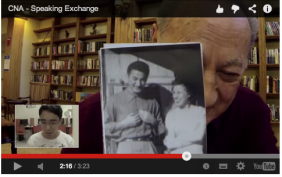
“I look like I’m only 25”, another man says. He and the boy a are laughing, “but I’m 88”. The two are having a nice conversation. In the end, they share a big, virtual hug.
The school uses its own digital tool for video chatting where conversations are recorded and uploaded privately for teachers to evaluate the talk language-wise.
But there is much more to this than just the language…
It’s fun and warms my heart to listen to their conversations about all the World and his brother.
Read more:
Modern Aging: inBelly

Today’s blog post is written by Kristina Saudargaite who is the founder of inBelly. This organization is already helping children at schools to have better food by identifying and classifying additives. Now, inBelly wants to branch out to another sensitive target group, the elderly. Read Kristina’s story here:
My name is Kristina Saudergaite and I love food. I love eating, cooking, going to the grocery store etc. I also love knowing what I eat. For this purpose, my friends and I once looked at the ingredient list. We saw many chemical names that we could not understand or tell how they affect our health. Thus, we checked.
The results shocked us! Commonly used E250 is classified by the International Agency for Research on Cancer as probably carcinogenic to humans or in simple words it is likely to cause cancer. E211 or sodium benzoate is not harmful on its own; however, it reacts with vitamin C and releases benzene – a known toxin. And who does not eat products often containing E211 such as shrimps together with a slice of lemon or maybe drinking Must with a salad
These are only a few examples; but food is increasingly stuffed with chemicals and this puts our health at risk.
The amounts of additives that may cause adverse effects are regulated by the EU. The problem lies in the fact that tests are made on healthy individuals (or animals). However, sensitive subgroups such as the elderly may be much more susceptive to the additives and adverse health effects related to them. Nursing homes do not have enough information to make sure that the food they buy do not contain harmful ingredients.
inBelly has the expertise and a rigorous database on food additives. Moreover, we have a technological solution that enables to quickly check if a product contains anything harmful.
In Sweden we have found many food products containing additives banned in other countries, such as Canada and/or linked to diseases. This knowledge exists in academia and in public documents but since the information is presented in a complicated and scattered manner, it rarely reaches the wider public. inBelly is unique since it uses official and scientific information about food additives and depicts it in a non-scientific “easy-to-understand” kind of way. The app simply shows a sign indicating that the scanned product contains additives banned in other countries. Our service innovation lies in using a mobile solution to translate knowledge from academia into simple visual signs in order to make the information quickly and easily available to everyone. With our mobile app people can scan barcodes and get information whether this particular product contains any ingredients that may be linked to diseases. The initiative won the Stockholm Innovation award in the service category 2012.
We are currently using this knowledge to help pre-schools to choose better food. We are cooperating with the chef at Globala Gymnasium to go through the products they purchase and analyse if any of them contain additives that may be harmful. This helps the institutions to ensure better food.
Since the elderly, similarly to children, is a sensitive group, we plan to offer our services to help nursing homes to go through the food they serve the elderly and check if they contain harmful additives. This would ensure good quality food and best possible health and wellbeing for the elderly.
Follow inBelly on facebook.com/inBelly or on Twitter @inbelly_guide
Source: http://www.socialinnovation.se/sv/modern-aging-blog-inbelly/
Modern Aging ideas – new blog series

Our most loyal readers on Silverevolution may remember the program Modern Aging that we wrote about in April (see the post HERE). This innovation program for young entrepreneurs with ideas for the elderly kicked off in August this year. A group of 7 entrepreneurs have been selected based on the potential of their improvement idea as well as their motivation to lead the way in transforming the elderly care sector. We are currently in the act of developing their ideas with the help of mentors and coaches and in close discussion with the elderly themselves. During the next couple of weeks the participants will blog about their ideas on the Forum for Social Innovation Sweden and we will post them here on Silverevolution as well.
First in line; introducing himself and his idea is Victor Nordlind. This is his story:
One may ask why a person who is attending one of the world’s top hotel schools would want to pursue a career in developing and improving the elderly care. Most people expected me to walk in my father’s footsteps in the restaurant industry, rather than radically changing field to Elderly care.
But as I was required to carry out a feasibility study about an existing retirement home during my first two years at Ecole Hôtelière de Lausanne (EHL), I was given the opportunity to see the true potential within this industry. It encouraged me to apply for an internship within elderly care, which I am currently pursuing within Strategy and Business Development at Ambea Sverige, whose affiliation is Carema Care. For me, elderly care is an industry where innovation is necessary in order to provide the correct quality of life, which in my opinion is the meaning of hospitality.
When I first came across the Modern Aging program, I did not have a specific idea for elderly in mind. When developing the idea, it was equally important to link the project back to my studies, as to work with something that may truly make a difference within the elderly sector. I decided to contact a friend who has several years of experience within elderly care, and who is currently working in a nursing home here in Sweden. I was convinced that my determination combined with her extensive experience would bring something innovative out of the meeting.
As expected, we had a very interesting discussion, which brought several ideas to the table. Most of them were linked to the use of more technology, which is a frequently debated topic when talking about improvements within elderly care. The trend of using technology to improve efficiency is relatively new in the industry while it has been an essential part of the hotel and restaurant industry for years. More and more apps and other technical devices are being developed to simplify everyday activities for the elderly.
However, one question that came up during the meeting was “how can we use technology to better involve the caregivers within elderly care?” These professionals have valuable knowledge and experience, which they should be able to share easily. With today’s progression of social media and online forums, a place for caregivers and other health care professionals to meet online should be developed. There, they may share ideas, knowledge and ask questions to one another over space and time. This will not only simplify and streamline the daily work, but it will also improve the quality of care in nursing homes in the long run. A forum like this needs to be strictly confidential with only registered users permitted access. The idea is also that this platform shall be the forum that compiles and disseminates knowledge of the latest advances in medical, social and technological solutions for the elderly.
My current internship at Ambea combined with the Modern Aging program has helped me to better understand the current market as well as the future prospects of elderly care in Sweden. To date, Modern Aging has hosted several seminars and workshops carried out by inspiring guest speakers from various fields, such as young entrepreneurs, lecturers from top universities, and professionals from the public health care sector. With this promising start, I am curious and eager to find out where the program is going to take us.
2050 – Projecting the magnitude of demographic change worldwide
“I see old people” is how this chapter begins. I’m reading “The new North – The World in 2050” by Laurence Smith. Without having finished the book, I’m excited to share some of the thoughts. This chapter really struck me.

Smith is a young professor in geography and earth and space sciences at UCLA. In his book, he analyzes four key “megatrends” – population growth and migration, natural resource demand, climate change and globalization – and projects how our world could look like in 2050.
The world is filling up with old people. Smith begins by describing the four stages of the demographic transition, which is happening everywhere in the world: 1. High and similar rates of birth and death (e.g., the preindustrial era, with a small and relatively stable total human population); followed by 2. Falling deaths but not births (initiating a population explosion); followed by 3. Falling births (still exploding, but decelerating); and finally 4. Low and similar rates of birth and death (population stabilization at a new, higher total number.
He states that most OECD countries have now passed through these stages – except for those allowing high levels of immigration like the USA – and have stabilizing or even falling populations. Most low- and middle-income countries are still in stage 2 or 3 though.
Smith summarizes that urbanization, modernization, and the empowerment of women push fertility rates downward. In other words, the urbanization of society (if associated with modernization and women’s rights) helps slow the rate of growth (with exceptions). In low-immigration developed countries like Italy and Japan, and regions like Eastern Europe, populations are falling. Consequently, if fertility rates continue to drop as they are now, the world population might be around 9.2 billion in 2050 – the population will still be growing, but about half as fast as today.
One of the most profound long-term effects of women having fewer babies is to skew societal age structure toward the elderly. Of course, improving healthcare also extends our life spans. This aging will hit some places faster and harder than others. Today, Japan is the world’s most elderly country with a median age of 44.6 years. In Pakistan, in contrast, the median age is just 22.1 years. Korea, Russia and China will join Japan as the world’s geriatric nations. Korea, Vietnam, Mexico and Iran will age radically by fifteen years or more. Countries like Afghanistan, Somalia and the Democratic Republic of Congo will still have youthful populations in 2050. 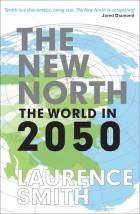
Smith asks: Is an elderly population a good thing or bad? He describes a possibly wiser and less violent society, which at the same time strains healthcare systems, and raises the economic burden on younger workers. The whole concept of “retirement” is about to undergo a major overhaul – people will have to work later in life. Big cultural shifts will be needed in the way we treat and value our elderly. Society must learn that aging and youth should be valued equally.
As the world grays, skilled young people will become a more and more craved resource, Smith concludes. Thus, those countries best able to attract skilled foreign workers will fare best. These young workers might come from Somalia, Afghanistan, Yemen, the West Bank and Gaza, Ethiopia, and much of sub-Saharan Africa, which will offer our world’s youth in 2050 based on current population structures.
Finally, the critical but open question that Smith poses is whether our poorest countries will be able to turn their forthcoming demographic advantages into the new skilled workforces needed to help care for an elderly world. This would require enormous improvements in education, governance and security. Women would have to start attending school and working in places where this is uncommon today. Terrorism would have to be sufficiently quelled. The countries that need young workers would have to accept immigrants from the countries that have them.
Hopefully, these things can be achieved.
PS: Check out Laurence Smith on Vimeo: http://vimeo.com/15715690
Innovating health through just-in-time evidence-based information
Hearing the term health care innovation, most people associate it with new technologies like robotic caregivers, digital imaging or breakthroughs in chronic disease treatment. The decision-making process towards the use of any of those innovative choices is based on the physician’s knowledge and experience.
“Healthcare innovation can be defined as the introduction of a new concept, idea, service, process, or product aimed at improving treatment, diagnosis, education, outreach, prevention and research, and with the long term goals of improving quality, safety, outcomes, efficiency and costs” (Omachonu et al. 2010). Thus, process innovations focus on improving quality of care for patients and enhancing health providers’ internal capabilities. However, innovation is difficult – the health field has rich evidence-based innovations, but they disseminate slowly, if at all (Berwick 2003). Six areas have been identified in making or breaking innovation in healthcare (Herzlinger 2006):
- Policy
- Stakeholders
- Funding
- Technology
- Customers
- Accountability
One opportunity to introduce innovation in healthcare is the use of evidence-based information, which is highly relevant to that particular patient – especially at the point-of-care. But how can the use of this kind of information be facilitated?
One tool that I came across is Elsevier’s ClinicalKey (www.clinicalkey.com). It is a tool that physicians can use to access evidence to make informed decisions at the point-of-care and throughout the patient journey. The ClinicalKey reference system links clinicians, medical librarians, and researchers to an online platform, which contains content from medical journals, books, multimedia, MEDLINE abstracts and other sources. Did you come across any similar tools?
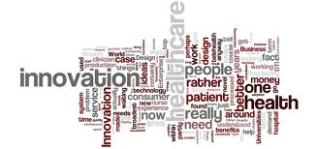
To me, fast access to high-quality research evidence to inform decision-making in clinical practice is absolutely important for innovating – improving – health. What do we need to solve this?
Maybe we need harder, better, faster, stronger tools as such, but what I wonder more about is the role of stakeholders as the leaders in these processes. How can leadership for evidence-informed decision-making in health be encouraged? How to cure resistance to change and innovation?
References
Berwick DM (2003). Disseminating innovations in healthcare. JAMA, 289(15):1969-1975
Herzlinger RE (2006). Why innovation in healthcare is so hard. http://hbr.org/web/extras/insight-center/health-care/why-innovation-in-health-care-is-so-hard
Omachonu VK, Einspruch NG (2010). Innovation in healthcare delivery systems – a conceptual framework. The Innovation Journal: The Public Sector Innovation Journal, 15(1):2.
www.clinicalkey.com
http://www.youtube.com/watch?v=gAjR4_CbPpQ
Image: http://www.tcd.ie
Elderly with iPads
A while ago I received an email from a developer at the Social Service Center in a municipality located in the south of Sweden. She had bought 30 iPads that she had distributed to disabled, elderly, drug addicts and mentally ill adults within the municipality. She wrote to me as she and her colleagues were amazed by the results! A young mentally disabled man who normally did not move much, all of a sudden became very active to everybody’s surprise. The personnel filmed him with an iPhone and sent to his parents who were thrilled. An elderly Czech woman with dementia got the opportunity to listen to her native language on the iPad. The happiness that brought to her was enormous. An elderly man known for always acting out and being aggressive became calm and happy simply from watching puppies on the iPad. An elderly lady photographed herself from different angles making sure she looked her best in every picture, strengthening her self-image and self-esteem.
In addition, the elderly could easily stay in touch with relatives, near and far, by using Skype. The drug addicts were able to go online and read magazines, play games, paint and play instrument through the iPad.
The woman who emailed me concluded by saying that these changes in behavior may look small and insignificant but for the people going through this it is of great importance. This is a great example on how we can update the way we provide care for the elderly and invite them to take part of the high-tech devices that have already become a natural part of our lives.
How grandma celebrates Christmas by herself
I came across this article from the UK about elderly people spending their merry Christmas on their own. I found it interesting, depressing, and even discovered a link to health in the whole dilemma.
While for many people Christmas is the only time in the year when they actually meet family and friends, others are not cared for by anybody or do not care for anybody (anymore). Thus, they spend the celebration of love alone, like a quarter of all people in the UK that are older than 75 and live by themselves – even though the majority of them have children.
Experts say that “family breakdown is fuelling an epidemic of loneliness in old age” and that the fact that two in five marriages fail has serious impacts for the elderly. Young people have to divide their time between parents and step-parents. Besides, ‘silver separations’ are also becoming more common, with latest figures showing that more than 11,500 over-60s were granted a divorce in 2009.
In one of the largest surveys of its kind, the think-tank polled 2,000 over-75s to test how isolated the elderly truly are. ‘I’m 88 and I have nobody at all. I’m on my own’, said one, and ‘some days the only person I speak to is the boy in the shop when I pick up my paper.’
Growing isolation and loneliness makes elderly people particularly vulnerable – also in terms of health. Related mental and physical health conditions include a weakened immune system, sleep deprivation, higher blood pressure, a higher risk of dementia and depression. What to do?
In the UK there is an initiative that involves the police, fire officers conducting home safety checks, as well as social workers who see “warning signs” to connect people to local voluntary groups that can provide companionship. But is that a solution of the problem really?
——-
Chapman J (2011): 250,000 elderly people who’ll be spending their Christmas alone. Available: http://www.dailymail.co.uk/news/article-2078261/250-000-elderly-people-ll-spending-Christmas-alone.html#ixzz2FXDlyfWT
Science fiction medicine from Sweden
Imagine you were able to simply replace one of your organs once you fall sick. You just go to the hospital and quickly come out with a new intestine, kidney, liver or even heart, if an incurable disease was present. This sounds more like an idea from a science fiction movie than a like a feasible therapeutic option, but research on regenerative medicine and the engineering of “artificial” organs is happening to make these options a reality for many patients worldwide in the near future.
Nowadays, chronic diseases are a major health issue in almost every country – they cannot be cured and the patient’s best bet is to prevent those diseases and their complications. We are talking about e.g. diabetes, heart and kidney failure, hepatic disease and hypertension. After treatment has failed the last resort for many patients is organ transplantation. However, as simple as it may sound, there are countless complications involved, as the organ has to be compatible with the patient. The patient will have to remain on medication to lower his immune system response to the minimal for the rest of his life, which can make him more vulnerable to infections.
By the year 2010, over 90,000 people were signed in for the waiting list for a kidney transplant in the US and 3,000 at any given day for a heart transplant. Many patients who have no other choice of treatment wait, and most of the times death arrives faster than the suitable organ.
What if you could build a custom-made organ according to a patient’s need? A group of biomedical researchers at Karolinska Institutet in Sweden have pioneered what can be the first step in the beginning of a science fiction medicine: working with stem cells, which are cells capable of giving rise to any human tissue. They have managed to make a fully artificial trachea from scratch and implant it in a patient with cancer without any immunological reaction. The newly formed organ is built on a PET mold, yes the same used in bottles, which is as anatomically identical to the patient’s actual trachea – not only in shape but also in composition. The mold is filled with stem cells from the patient himself. Giving rise to a new and fully functional organ ready to be replaced.
The patient who went under this treatment is currently under annual checkups while living a normal life without health related restrictions. This is only the first step, but it is a firm step.
Thanks to Antonio Beltrán Rodríguez for sharing this post with our silverevolution-readers. Antonio is a biomedical student at Karolinska Institutet. Contact: antonio.beltran@stud.ki.se
And tomorrow WALL-E is taking care of you
 Nowadays, a lot of research is conducted in the area of healthcare robotics, which has the potential to increase the quality of life for our silver population. Imagine!
Nowadays, a lot of research is conducted in the area of healthcare robotics, which has the potential to increase the quality of life for our silver population. Imagine!
I would like to tell you about the examples of New Zealand and South Korea – two countries that are combining their knowledge in order to build and develop something groundbreaking. Here, South Korea contributes from the hardware-side, while New Zealand is busy developing the latest software (check out: HealthBots Project, launched in 2008).
Healthcare robots that can take grandma’s heart rate or blood pressure are the outcome of the research. But besides simple medical jobs, robots can also play a tremendous role in monitoring, as they are able to store and manage the patient’s relevant medical data. All this can make elderly care much more cost-effective.
Another idea is that robots can enhance old people’s quality of live by offering entertainment, e.g. through music, films, games and the use of social media as Skype.
——————-
All this sounds futuristic, but the question is if it is a concept that will be feasible: Will decision-makers be willing to invest in healthcare robotics? And will our grandparents (our parents? we? our kids?) enjoy interaction with robots? A lot more studies have to be carried out in order to find out more about cost-effectiveness, but particularly about interaction between human beings and machines – and thus, about the increase (or not) of people’s quality of life.
Healthcare robots could change lives: http://www.msi.govt.nz/update-me/success-stories/research/healthcare-robots-could-change-lives/ (December 2011)
23 and 1/2 hours
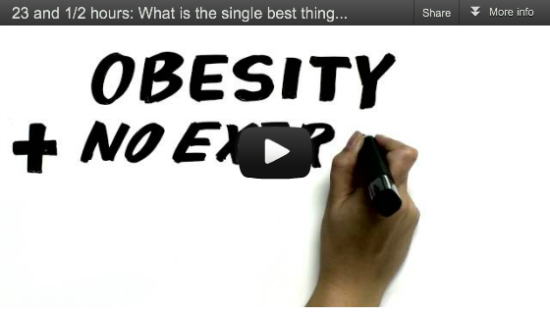
There seems to be one single, simple best thing to keep our lives healthy and to prevent especially non-communicable diseases: a small, but regular dose of physical activity. This is especially relevant for elderly people as they often suffer from multi-morbidity, but could potentially stay more healthy by changing their lifestyles just a little bit.
Wouldn’t it be easy to put eating and sleeping in 23 and 1/2 hours and keep 30 minutes for physical activit? It doesn’t even have to be on a daily basis, but e.g. going for a 30 minutes walk three times a week has already proven to reduce the risk for arthritis by 47%, for dementia by 50% and for diabetes by 58%.
So how about prescribing physical activity? If doctors did that for their patients – do you think it would have an impact on people’s health?
Check out this video by Michael Evans and Mercury Films Inc. http://www.youtube.com/watch?v=aUaInS6HIGo. It has also been posted by the Swedish Professional Association for Physical Activity. http://www.yfa.se/
Also check out Michael Evans’ blog: http://www.myfavouritemedicine.com/23-and-a-half-hours/
U-health in Korea
Our teacher once accused us: “You’re incredible! What you guys don’t find on Wikipedia does not exist in your world – or what?”
Trying to find out more about “u-health”, I remembered that and it made me smile. U-health or u-health care cannot be found on Wikipedia (yet) and on the first sight it does not seem to be on many peoples’ minds in today’s world, but dig a little deeper!
U-health stands for ubiquitous health – omnipresent, universal, ever-present health. Sounds big! And there you go with your online-search… [Small note: I found so many interesting aspects that I don’t know where to start now – so let me just give you a basic idea with this blog post and let’s explore the topic further within the following ones.]
On the Congress on Nursing Informatics 2006 in Korea, u-health did cause lively discussions. The Korean Government had started a project on u-health services for the provision of health care services in the country’s rural areas using the advanced broadband infrastructure (NI 2006).
U-health care is a developing area of technology to monitor and improve a patient’s health status. It uses different environmental and patient sensors to gather data on almost any physiological characteristic to diagnose health problems (Brown et al. 2007). U-health should stand out through availability, transparency, seamlessness, awareness and trustworthiness – anytime and anywhere (Cha 2008).
Many industrialized countries are sitting on a demographic time bomb – facing problems in health care that are related to the growing number of elderly. Their limited resources in health need to be used more efficiently and effectively. So especially these societies could benefit from u-health care and its innovations to reach better diagnosis and treatment. It also has a lot of potential in improving hospital administration and patient management with reduction of medical errors, and in enhancing service quality, communication and collaboration. (Chang) However, at the same time, u-health care confronts ethical issues, e.g. when it comes to trust, privacy and liability, or in combining computer and information ethics with medical ethics (Brown 2007).
Hence, the bottom line is that yes, u-health is and will increasingly be on peoples’ minds (and it will probably soon appear on Wikipedia).
Societies as well as individuals will have to make difficult choices in the future.
1 Korea IT Times offers a variety of more interesting articles by Cha Joo-hak on the topic: http://www.koreaittimes.com/source/cha-joo-hak
2 Brown I and Adams A A 2007. The ethical challenges of ubiquitous healthcare. International Review of Information Ethics Vol. 8. www.i-r-i-e.net/inhalt/008/008_9.pdf
3 Cha J-H (2008). Defining the Perfect Ubiquitous Healthcare Information System. Korea IT Times. http://www.koreaittimes.com/story/56/defining-perfect-ubiquitous-healthcare-information-system
4 Cha J-H (2010)Who Shall Live Better? – Health Care and Socioeconomic Choice. Korea IT Times. http://www.koreaittimes.com/story/8559/who-shall-live-better-health-care-and-socioeconomic-choice
5 Chang B-C ().Ubiquitous-Healthcare Changed paradigm after introduction of EHR. Yonsei University. www.health-informatics.kk.usm.my/resources/2_Chang.pdf
6 NI 2006. The 9th International Congress on Nursing Informatics. Seoul, Korea June 2006. http://differance-engine.net/ni2006blog/?p=22
The Elderly on Building Disaster Resilient Communities in the Philippines
Extreme weather conditions will become the norm in the Philippines, with long droughts and massive floods punctuated by intense typhoons, experts report. The monsoon alone that the country experienced early August displaced more than 260,000 people and caused damages to property amounting to an estimated Php 340 million. Communities now face the challenge of adapting to manage and reduce the adverse effects associated with these weather disturbances.
Vulnerable groups are most affected by calamities. These groups include women, children, persons with disability, and the elderly. Given that the Philippines is visited by an average of 20 typhoons annually, and is largely archipelagic, making emergency response a daunting task in far flung areas, each sector must contribute to building resilient communities locally.
In the aftermath of the heavy rains caused by the August monsoon, ACCESS Health International-Philippines organized the webinar, “The Elderly in Disasters” to begin a conversation on how to care for the well being of vulnerable groups who are displaced in calamities. The invited resource person to speak for the elderly was Mr. Francis Kupang, Executive Director of the Coalition of Services of the Elderly (COSE).
Mr. Kupang gave inputs on Older People’s (OPs) Needs in Emergencies, specifically (1) the situation of OPs during disasters, (2) their needs and the problems they encounter in crisis situations, and (3) how organized OP groups participate in emergency relief services-emphasizing the role of empowered OP groups in building resilient communities.
The salient points shared by Mr. Kupang is that OPs are vulnerable during disasters because of their fragile physical condition and because the setting in evacuation centers are usually not OP-friendly. It is also in the nature of OPs to sacrifice their well being to give way to addressing the needs of the young-usually, their grandchildren or neighbors. Health also becomes a great concern for the elderly during disasters because provisions for their medicines (e.g., for diabetes, or hypertension) are usually taken for granted because priority is given to food and other basic needs.
The awareness of these vulnerabilities have inspired organized local OP Organizations (OPOs) to provide a range of services for their fellow OPs. Some have initiated programs related to livelihood, post-calamity psycho-social interventions, alternative energies, shelter repair, and workshops on Disaster Risk Response (DRR) and building community-based mechanisms in responding to future disasters. Through these efforts, Mr. Kupang noted that OPOs are actively engaged by different emergency service providers including national and local government units (LGUs), and civil society organizations (CSOs)and religious groups who organize calamity relief efforts.
As they continue to participate in building resilient communities, OPOs have formulated recommendations on how to address the unique needs of OPs in emergency situations. Mr. Kupang enumerates the following inputs from OPOs:
- Conduct a Damage Need Assessment (DNA) in partnership with the OPOs in the community;
- Establish coordination or working relations with OPOs in emergency response;
- For national government agencies and LGUs to designate a point person to coordinate all emergency services with OPOs;
- Prioritize basic needs for food and health of OPs during emergencies;
- For Government agency and LGU emergency service volunteers to have proper orientation and knowledge of how to address OP needs during emergencies;
- LGUs should develop a comprehensive Disaster Risk Reduction and Management (DRRM) Plan that integrates OP-sensitive policies and measures in emergencies;
- Enchance OPO participation in DRRM planning and implementation;
- Establish baseline information of the capacities, vulnerabilities and needs of OPs at all levels of political units (towns, cities, municipalities, etc.);
- Enchance and / or strengthen the participation of OPs and OPOs in the identification of their problems and needs, and the planning and implementationof community development programmes, including DRRM programs;
- Integrate OP agenda in all levels of government planning and program development structures and processes;
- Building partnership with Non-Government Organizations (NGOs) and CSOs in facilitating the formation and / or strengthening of community-based OPO partners in participatory development practice.
Sources:
Abano. Imelda. “Experts: Extreme Weather Becoming the Norm.” Business Mirror Online 30 August 2012 <http://www.businessmirror.com.ph/home/top-news/32096-experts-extreme-weather-becoming-the-norm>.
Tapang, Giovanni. “Pagasa and Hope.” Manila Times.net 16 August 2012 <http://www.manilatimes.net/index.php/opinion/columnist1/29030-pagasa-and-hope>.
The Philippine Telegeriatric Pilot Project: How did it Start?
Access Health Philippines promotes innovations for the healthcare delivery system so that “all people wherever they are, have access to quality and affordable healthcare”. In partnership with Asian Institute of Management – Dr. Stephen Zuellig Center for Asian Business Transformation (AIM-ZCABT), a Telemedicine Project was formed with an ultimate goal of filling the gaps of widening problems in health access and shortage in the number of health specialists.
Elderly in the Philippines comprises 6.8% of the total population (NSCB, 2010), which means 1 out of 5 households have senior citizens. Older people have special needs and challenges in accessing healthcare services. The physical and cognitive disabilities limit their capacity to travel and access healthcare. They need specialist care providers for the aged. With the lack of access or difficulty to access health care, distance medication can be of great help to this sector of the society. This brought the telemedicine team to propose a start up project for the elderly population which is known as the “Telegeria”.
A Telemedicine team was formed which composed of members from different sectors which have stakes in providing better healthcare for the elderly. They are the Ayala Technology Business Incubation– ACCESS Health Philippines, AIM SRF/AIM ZCABT, ClickMedix, Total Transcription Solution Inc., Coalition of Services of the Elderly, Inc. (COSE) and Alliance of Young Nurse Leaders & Advocates International Inc. (AYNLA).
The Team initially chose to pilot the project in one of the major cities in Metro Manila. However, with a show of hesitation and delayed response from the involved staff, the Team prompted to look for another entity that was willing to adopt the concept and pilot the Telegeria. This is the Home Health Care (HHC) in Quezon City.
HHC specializes in delivering wellness programs and services to seniors and persons with disability in the comfort of their homes. It has a multidisciplinary expert team of physicians, registered nurses, physical therapists, nutritionists/dieticians, medical technologists and trained caregivers. They have been cited as a community resource providing quality home care for seniors across all settings.
HHC agreed to participate in the project seeing the opportunity for a potential innovation that could improve their management system in providing better and more cost-effective health services towards their clients. A virtual clinic from ClickMedix system was given to HHC for a free trial of one full month. This was applied in their four senior residential facilities.
Check out for the continuation of this project in the coming blogs. This pilot project is being documented by the Program Coordinator and Program Associate of AIM-ZCABT, Davidson Teh and Jayson Soriano, respectively.
Design for dementia

My co-blogger Stéphanie Treschow earlier blogged about an inspiring London-based fashion brand for pensioners by a young female fashion school graduate, Fanny Karst, designing clothes for women three times her age. I don’t know if Hampus Rendmar, a recent graduate from Konstfack (University College of Arts, Crafts & Design) in Sweden, had heard about her and gotten inspired or if we might be seeing an emerging trend among art/fashion school graduates, but his recent graduation project had a related audience – people with dementia.
Hampus feels that interior design at today’s nursing homes lags behind in general and says that dementia patients have the same right to trends and design as does everyone else. He means that many dementia patients must have gotten tired of the old and worn traditional furniture that fills residential care homes today. Therefore he has created a series of furniture targeting this audience with a focus on design that gives a sense of calm and safety. ‘Calm’ is also the name of two chairs in the project, made out of beech and steel, that have been painted in mediterranean green, since it is said to have a calming effect. Furthermore the chairs have a rocking effect, something that research has shown can diminish worry and stress.
What is up next for Hampus is yet to be told, but both visitors at the final art graduation projects’ exhibition by Konstfack and he himself noted that his furniture was widely popular among the audience throughout the whole exhibition. Maybe ‘Calm’ is soon to be found in a nursing home near you.
Source (in Swedish): http://www.dn.se/bostad/han-vill-ge-dementa-god-design
Image source: http://blog.trendgruppen.se/?p=10760
Innovations in Personal Transportation Vehicles: Challenge or Opportunity?
Dean Kamen’s Segway® Personal Transporter (PT) unleashed waves of enthusiasm with its release in 2001 quite frankly as a vehicle for the new age. The self-balancing gyrometers — with their fascinating ability to sustain an upright position — posited a truly bizarre realization for our populace: that times are changing and we need to be ready for it.
This realization certainly does not exclude the elderly population, whom have gone perhaps through the most changes humanity have ever faced in history; with such a dramatic recombination of technology in this past century.
If you browse through search engines and correlate the Segway with the elderly, you won’t find many innovations concerning our aged population. You will find concerns on how the elderly view such devices as the Segway — particularly the operator not being able to control it safely enough in order to prevent collisions with said elders. Forums may reveal that Segways are user-friendly for the elderly if they wish to operate them for themselves, however, safety and bug issues are always notable. It is difficult to find information, if any, regarding devices such as these specifically tailored for those in our population who require more care in their designs for mobility.
Personal Transportation Vehicles such as the Segway have brought a hallmark of inventive changes for the general population. Now, however, with a global, dramatically aging population, focus needs to be directed on the safety and effectiveness of such devices for those with more frail or limited mobility.
—
References
http://www.segway.com/about-segway/index.php
http://www.ehow.com/list_6884791_segway-safety-issues.html
http://www.caregivershome.com/news/article.cfm?UID=1097
Happy times a comin’ – majority of to-be pensioners optimistic about their future

Graph description further down.
When my little brother was a kid he used to answer the question of what he wanted to be when he grew up with a firm and certain: ‘a pensioner’. Quite insightful, I must say, for a 5 year-old, but I guess he’d simply realized what so many pensioners-to-be are starting to realize as the day of retirement draws nearer. According to a recent study of the state of the elderly and elderly-to-be in Sweden, the UK and the US, life satisfaction increases steadily from the age of 47 and four out of five in this age group have a positive view of their coming years in ‘life’s third act’. This all the while two thirds of the same respondents fear that the care system for senior citizens will not be able to look after them when their time comes.
The study, presented by Kairos Future in cooperation with a number of Swedish companies and institutions*, is Kairos Future’s fourth in line of studies of attitudes among the baby boom generation. Previous studies being carried out in 1999, 2004 and 2008, they have all followed the same baby boom generation born in 1945-1954. It was first in the third one that the scope was expanded to include also the UK and the US.
Below I share a couple of highlights from the study:
1. Contentedness of life in general increases steadily from the age of 47. Graph above depicting contentedness of life. On the y-axis the scale of contentedness and on the x-axis year of birth of respondent. The arrow points at respondents of 50 years of age. As graph shows contentedness of life increases steadily from just before this point in time (and has a bottom low between age 35-45 (youngest respondents of study were of 30 years of age)).
2. The primary focus of most to-be pensioners is to stay healthy, both physically and mentally. To keep the brain alert and maintain an active lifestyle are top priorities for most baby-boomers. Many also say that they want to keep contributing to society to a larger extent than in earlier studies and statistics also reflect this fact showing that the number of 66-year olds that are still working have increased from 19% (1997) to 36% (2009). This is also reflected in that few of the already retired wish that they would have retired earlier (only 7%), whereas a larger group wish they would have retired later (20%). Which leads me to the last of the interesting findings I have chosen to highlight.
3. Many suspect that society’s elderly care won’t be able to support them, when they reach the later stage of the Third Age. As many as 37% of the baby boomers, and 35% of the 30-55 year-olds doubt this. Kairos Future have created an interesting graph depicting how society’s changing demography in the past century puts a lot more pressure on the working generation in order to sustain those not working, since we both start working later in life, and live longer after retirement today, than 90 years ago. Question is – will society be economically sustainable with people only working one third of their lifetime (as suggested will be the case if the demographic development continues til 2040, without changes to the number of working years)? Or will things have to change, and in that case, how? Is the current debt crisis around the world maybe even an early reflection of society’s debts to its people that is simply running out of hand due to the demographic changes with people living longer and longer? Interesting questions asked by Kairos Future and visualized through the following graph:

Average duration of different periods in life at different points in time (1920-2040). X-axis shows between which ages each period of life approximately runs and the periods (as explained in the top right corner) are, from the top: Childhood, Emancipation, Freedom years, Responsibility years and Old age.
So, to sum it up, an interesting read.
On a final note, I just loved the introduction of the report where they presented a number of the new names that people have started to give to the people living in this new active Third Age: Such as Silver surfers, Passionists, Passioners, SALLIES (Senior Affluent Life Lovers Enjoying a Second Spring), OPALS (Old People Active Lifestyle) and MAPPIES, (Mature Attractive Pioneers). Now that’s some granny! 😉
* For the curious: SEB, SPV, Micasa Fastigheter in Stockholm AB, Apotek Hjärtat, Pensionsmyndigheten and Friskis&Svettis.
Source (where you can also find the report for download (unfortunately only available in Swedish)): http://www.kairosfuture.com/publikationer/framtidens-%C3%A4ldre?pub=Framtidens-%C3%A4ldre
Migration of Korean Nurses like Mama
“Yes, I’m also half Korean. My Mama is also a nurse!” My name is Olivia Biermann. I’m a half Korean German living and studying in Sweden. My Korean-German classmate was not the first person that I met during the past years having the same roots as I do. There are people in my generation whose mothers are nurses from South Korea who found work and love in Germany.
I always considered Mama a brave and curious person – coming to Germany when she was just 20 years old. Her older sister had already been working there as a nurse and Mama started nursing school once she had picked up enough of the German language. Then she met Papa. Mama worked in a hospital until she founded her own elderly care service a few years later. A few more years later she and Papa, who is a civil engineer, initiated a small nursing home, which has become a popular shared flat for 12 lucky seniors in our hometown.
I have always looked at it from Mama’s perspective and understood why she decided to take the leap and come to Germany. I have, however, never thought it through from the system perspective including her decision’s consequence for the Korean and the German health care systems and their silver generations.
The transnational migration of female nurses has long been a reality in South Korea and started with the dispatch of nurses to Western Germany in the 1960’s. This movement expanded as globalization proliferated. However, the reasons for migration of Korean nurses changed over time, and the inside story is not that unpretentious: Within the transforming Korean society, the only accessible profession and specialization area for women was nursing. After the Korean War (1950-53), the country’s government borrowed a development loan from the German government, and as a consequence, Korean nurses and mine workers went to Germany to serve that purpose. Nowadays, Korean nurses are leaving their country due to different reasons, e.g. excessive expectations from the Korean society, dissatisfaction through unemployment, stress, gender discrimination, poor working conditions and low recognition within the hospital.
This worldwide movement is leading to “brain drain” in countries like e.g. South Korea, which can be understood as an emerging social problem. However, there is actually a scarcity of job opportunities for nurses in South Korea, and their migration can also be seen as a phenomenon of the opening medical market, a solution to reduce unemployment and to acquire foreign funds to overcome the foreign exchange crisis. Finally, it gives those migrating nurses the chance to live in better conditions, earn a fair wage and fully express their capacities.
Advantageous brain drain or not – the wave of migrating South Korean nurses is getting bigger. Therefore, the meaning of today’s labor migration for the respective health systems should be studied in more depth. It is about finding out more through quantitative and qualitative studies about the releasing and absorbing countries, the migration systems, and of course the migrating individuals with their own personal history and identity.
As medical sciences advance and people get older, and thinking about Mama: Clearly, Mama is doing good for the demographic changes in our hometown, but how about her South Korean home which is facing similar challenges? How can the migration of nurses be in favor (or not) of the demographic change and health care?
Literature: Ga young Chung (2006). Transnational Migration of Korean Nurses: Labor, Gender, Global Migration – Case study of Korean Female Nurses, Working in Australia. Asian
Culture Camp: “Doing cultural spaces in Asia”. Session 15: “Global Contestation over Ecuation and Labour Market”. Yonsei University, Korea.







